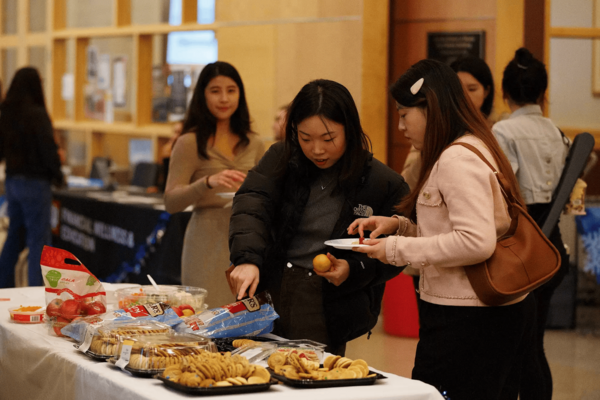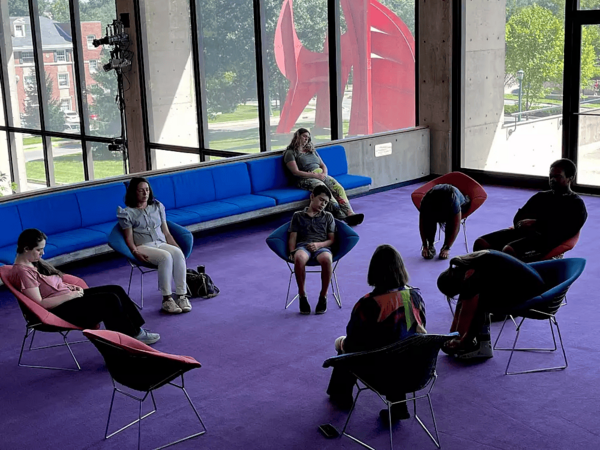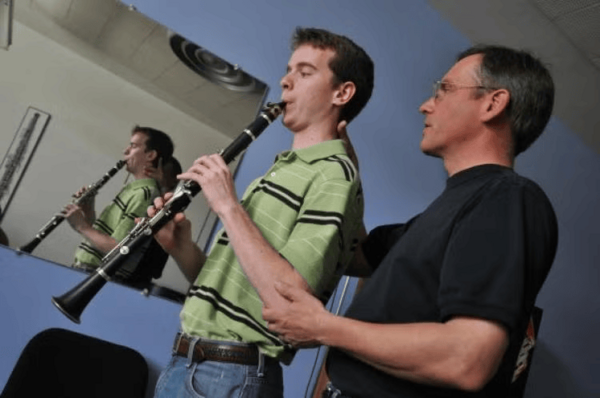Supporting Performing Art Students via Wellness Resources
The image of the suffering artist is a cliché that faculty and staff who work with students in the performing and visual arts are trying to dispel. They believe that creative inspiration doesn’t have to come at the expense of health and well-being.
“You definitely have to be able to connect on some level to that artistry. But that doesn’t mean necessarily that you have to suffer mental health issues to be able to access this,” said Frank M. Diaz, professor in the Indiana University Jacobs School of Music.
A growing awareness of young people’s mental health and the challenges depression and anxiety pose to student retention and college completion has inspired services for students of underrepresented minority backgrounds, student athletes and other populations on campuses.
Most Popular
More performing arts programs have also begun embracing education on emotional and physical well-being to equip students to succeed in college and beyond.
Performing arts students, like many college attendees, face academic pressures—as well as financial responsibilities to pay for college—that can put them under immense stress. A 2024 survey by Inside Higher Ed and Generation Lab found that just under half of respondents indicated their top stressor while enrolled was balancing academics with personal, family or financial responsibilities.
Performers also juggle rehearsals, whether individual training or as part of an ensemble, that can require several hours of work outside of regularly scheduled classes. Musicians are often in practice rooms for hours each day, causing them to deprioritize their well-being.
“Some of them practice for six hours,” Diaz said. “That does not include their academic courses, their music courses, their ensembles that they’re in, their lessons and their studio classes. While you pile all that on, it’s a lot.”
Young people in general are more open to talking about mental health compared to previous generations, but performing arts students often feel cultural pressures to maintain certain appearances.
“There’s a lot of stigma around the arts and mental health,” Diaz said. “Music students—we also have ballet here—don’t like to admit that they have issues. It’s seen as a weakness, so it’s been traditionally not talked about in our field.”
Additionally, the performing arts can put pressure on students’ physical health if they’re not trained or properly supported. A research study of music schools in Switzerland and the U.K. found music students had lower levels of physical and psychological health compared to the general population.
This unique combination of factors has pushed some colleges and universities to invest in specialized resources dedicated to students studying music.
Members of the National Association of Schools of Music, the accrediting body for most music programs, are required to provide music students with information about physical and mental health. Most institutions meet this requirement through a dedicated webpage where students can browse campus and external services. If you ask James Brody, director of the Musicians’ Wellness Program (MWP) at the University of Colorado, Boulder, College of Music, that’s just the tip of the iceberg.
Editors' Picks
Brody and his colleagues have been engaging in this work informally for over a decade. In 2020 the university rolled out an embedded counseling program, which provided the College of Music with a dedicated mental health clinician, Matthew Tomatz, to lead outreach and deliver services to music students. Tomatz, a former musician himself, receives referrals from faculty and staff to meet with students and provides regular group therapy for student musicians to engage with peers and talk about their struggles.
MWP was officially established in 2021, providing physical and social wellness education to learners across CU Boulder’s school of music to prevent and recover from injuries for long-term thriving.
Approximately 160 students participate in MWP offerings each year, and more than 130 music students accessed counseling and psychiatric services in the 2022–23 academic year, according to a university press release.
The Office of Wellness and Arts Health Initiative (OWAHI) at the Jacobs School of Music was established in 2023 as a way to increase student access to supports. The school is home to 1,600 students, making it one of the largest music schools in the U.S. The size can make music students more isolated from the larger campus community of Indiana University, because “everything [within the music school] is in one place and our students never go out and venture into this Big Ten campus that we have,” Diaz said.
Instead of making students seek out resources, the school centralized offerings into the OWAHI, creating a one-stop shop for a variety of support services that are student-centered and student-led.
One of the undertones of performing arts programs is competition; students fought hard to win a spot at an accredited music program, which can create feelings of rivalry and isolation from their peers.

Jacobs School of Music students enjoy a holiday party thrown by the Office of Wellness and Arts Health Initiatives in partnership with the Jacobs School’s Health and Wellness Committee.
Wendi Chitwood/Indiana University
To combat this narrative, Diaz created events centered on relationships. “Our data basically indicates that people are seeking community. They don’t know how to find it; they don’t know how to build good relationships. They know they want them. So, to me, that’s the basis of everything we do.”
OWAHI offers drop-in office hours for students to get snacks, talk with their peers and engage in destressing activities, including mindfulness training, massage, games and yoga. In addition, the office partners with the School of Social Work to provide student-led wellness coaching, which both connects learners with peers and gives social work students needed supervised practicum hours.

Jacobs students participate in a meditation session provided by the Office of Wellness and Arts Health Initiatives.
Jacobs School of Music/Indiana University
OWAHI offered about 70 coaching sessions in 2023–24 and an estimated 300 sessions during this academic year, which Diaz attributes to increased engagement on campus, student-led marketing and positive partnerships. Students who participate in services are also demographically representative of the school’s population, and Diaz has been pleased to see high participation rates among male students (41 percent of participants), given perceived barriers to engagement in mental health supports for men.
At New York Film Academy in Los Angeles, acting professor Victor Verhaeghe noted that his students tended to arrive with fewer socio-emotional skills, making it harder for them to engage. Verhaeghe has started using class time to lead meditation and shared affirmations, allowing students to become more vulnerable and connected to each other, as well as create self-love.
“I say, ‘Let’s start with sharing who you are; let’s open up to discussion,’” Verhaeghe said. “Some people are not ready to share, but I’ll share my story … It’s all about rewiring, it’s about changing the programming. As an artist, vulnerability is essential. You have to be able to tap into that.”
Injuries among college students often come from late-night recklessness, sports, accidents or overwork. Less common is the physical strain improper musical technique can have on musicians.
“People don’t understand that musicians get injured, and the injury rate is high—as high as 80 percent of college students,” Brody of CU Boulder said.
Brody offers one-on-one consultations and lessons with students to help them recover from injury, misuse, anxiety or physical tension, helping them connect music and the body to ensure they can continue playing for many years. “I am continually amazed at how anatomically illiterate most musicians are,” he said.

Professor James Brody, director of the Musicians Wellness Program, instructs a student musician on clarinet.
University of Colorado, Boulder
He’s passionate about physical wellness education for musicians, and admits he sometimes has to pull back from overloading students with anatomy lessons.
“Some people say, ‘No pain, no gain,’” Brody added. “I say, ‘No pain, no pain.’ It really shouldn’t hurt.”
CU Boulder music students can also receive free hearing tests, a common practice for music schools to ward against noise-induced hearing loss.
The University of North Carolina at Greensboro offers two elective courses within the school of music that connect physical health to performance, encouraging students to move strategically and reduce tension.
In the future, Brody would love to see donor support for more resources to support musician well-being, including specially designed hearing protection and vocal health support from a laryngologist.
College students in general are anxious about their careers—71 percent of students say they feel at least somewhat stressed thinking about life after college—but the performing arts has always been an especially challenging field. Recent data from the Bureau of Labor Statistics found that only about 20 percent of students with a fine arts degree actually work in arts, design, entertainment or media occupations.
“Every single student is terrified right upon getting out because of the complete unpredictable nature of this business,” Verhaeghe said.
Brody noted student musicians’ anxiety levels are high regarding their future plans, particularly due to a shrinking number of symphony orchestras and full-time opportunities. “Still, folks line up to do it,” he said. “We don’t have any lack of talent and motivation.”
In class, Verhaeghe talks about the challenging elements of being an actor, from not having work to playing demanding roles with long hours. “I think it’s important that we talk about the next phase,” he said. “I believe this is a calling to do this work, and not everybody’s called … if you really want to have a craft, then you will invest.”
Performing arts students also often live with the tension of trying to balance passion and work. Many people consider art to be a healing or soothing experience, allowing them to engage in mindfulness or relaxation. “The evidence is pretty clear that musicians and artists in general are the exception to the, ‘I do art and I feel good’ thing, like, we don’t experience that because it’s vocational,” Diaz said.
There’s one exception to this work, Diaz noted: when art becomes a service. At IU, students can participate in performances at senior centers through the Senior Outreach Program.
“Instead of going as ‘I’m going to perform this awesome thing with you,’ [it’s] ‘I’m going to connect with you, I’m going to go learn your name and learn what you like and perform for you at these senior community centers,’” Diaz said.
Faculty members agreed there’s a need to encourage students not to burn out or overexert themselves for the sake of their art, because it’s not sustainable in the long term and reduces their career potential.
“The culture is gradually changing because it has to,” Brody said. “If it doesn’t, it’s like feeding people into a wood chipper.”








